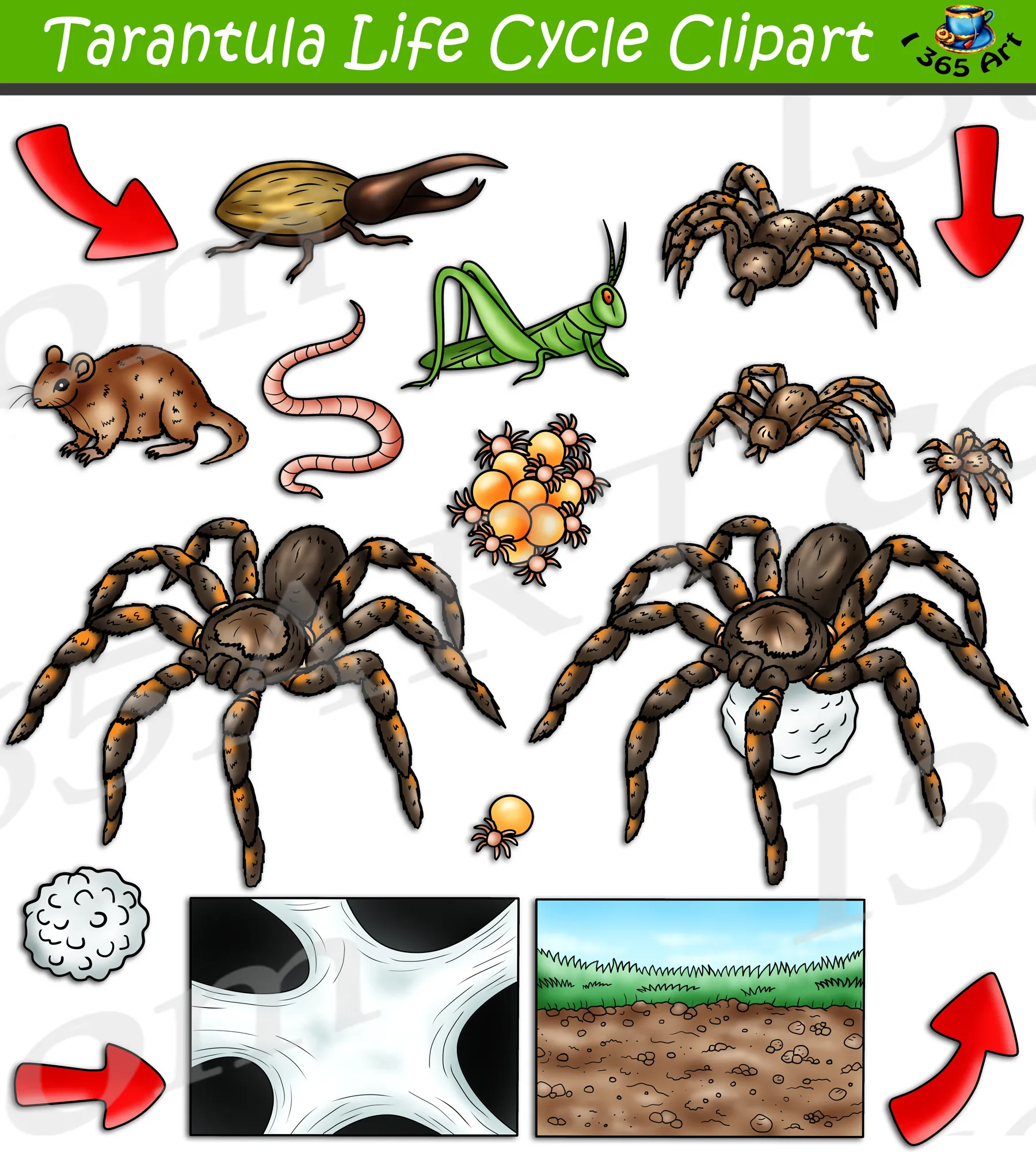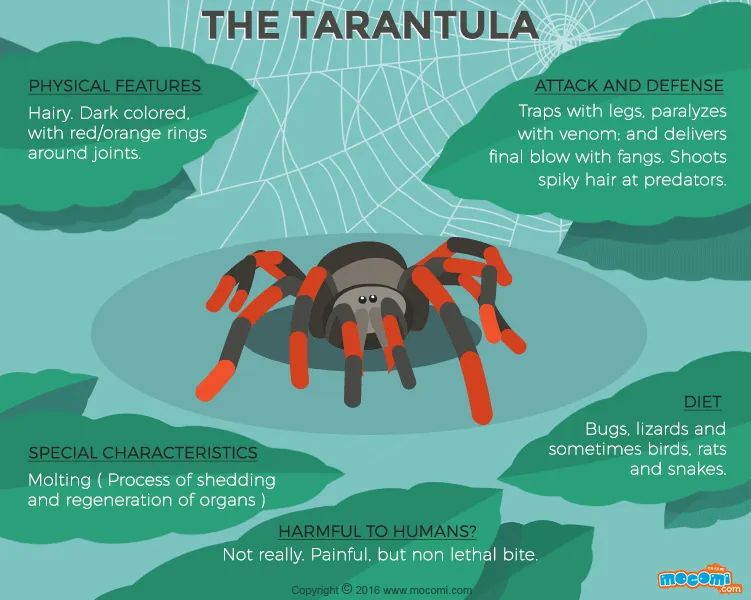What is a Tarantula?
Tarantulas, belonging to the Theraphosidae family, are large and hairy spiders that are famous for their impressive size and, in some cases, their striking appearances. They are found in various habitats across the globe, from deserts and rainforests to grasslands. Unlike many other spider species, tarantulas are known for their relatively long lifespans, with some females living for over 20 years in captivity. These fascinating creatures are primarily nocturnal hunters, feeding on insects, smaller invertebrates, and even small vertebrates like lizards and mice. Their bodies are divided into two main parts the cephalothorax (fused head and thorax) and the abdomen, and they possess eight legs, multiple eyes, and fangs used to inject venom. Despite their intimidating appearance, most tarantula species are not considered highly dangerous to humans, and their bites are often compared to a bee sting. However, they are capable of defending themselves using urticating hairs, which they flick off their abdomens as a defense mechanism. Tarantulas exhibit a diverse range of colors and patterns, with some species displaying vibrant hues, making them popular pets among arachnid enthusiasts. Their unique characteristics and life cycle have made them a subject of fascination and study for biologists and animal lovers alike.
The Egg Sac Phase
The tarantula life cycle begins with the egg sac phase, which is a crucial period in the spider’s development. After mating, the female tarantula creates a silken egg sac, often resembling a fluffy, pearly white ball. Within this sac, she lays hundreds or even thousands of eggs, depending on the species and the size of the female. The female diligently cares for the egg sac, protecting it and regulating its environment. She may turn it frequently, ensuring that all eggs receive proper oxygen and are kept at an optimal temperature. The incubation period can vary from a few weeks to several months, depending on environmental conditions and the species. During this time, the eggs develop into pre-larval spiderlings, preparing for their first molt. The egg sac phase is a critical period, as the eggs are highly vulnerable to predators, desiccation, and other environmental threats. The female’s protective behavior is vital to the survival of the offspring, making this phase a testament to the intricate and fascinating aspects of the tarantula life cycle. Understanding this stage is key to appreciating the complex processes that underpin the tarantula’s journey from egg to adult.
Hatchlings and Spiderlings

Once the eggs hatch, the tiny spiderlings emerge from the egg sac, representing a critical stage in the tarantula life cycle. These spiderlings are miniature versions of the adult tarantula, but their appearance and behavior are significantly different. They are initially pale and soft-bodied, with limited mobility. The spiderlings remain within the egg sac for a short period, absorbing nutrients from the remaining yolk sac. During this phase, they undergo their first molt, shedding their initial exoskeleton to reveal a slightly larger and more robust form. After the first molt, the spiderlings become more active and begin to disperse from the egg sac. They still rely on their mother for some protection, but their independence grows quickly. The spiderlings need to find food and suitable habitats. Their diet consists primarily of small insects and other tiny invertebrates. As they grow, the spiderlings molt periodically, shedding their exoskeleton to accommodate their increasing size. Each molt brings them closer to the appearance and characteristics of an adult tarantula. The spiderling phase is a time of rapid growth and development, during which they learn to hunt, evade predators, and establish their place in the ecosystem.
Molting and Growth
Molting is a fundamental process in the tarantula life cycle, allowing these arachnids to grow and develop. The process involves the spider shedding its exoskeleton, or outer shell, to reveal a new, larger one beneath. Molting frequency varies depending on the age and species of the tarantula, with young spiderlings molting more frequently than adults. Before molting, the tarantula stops eating and becomes less active. It may also create a web mat, providing a soft surface to molt on. The molting process itself is a delicate and vulnerable time for the tarantula. The spider lies on its back, and the old exoskeleton splits open, typically along the cephalothorax. The tarantula then slowly pulls itself out of its old shell, revealing a new, soft, and often brightly colored exoskeleton. The new exoskeleton is initially soft and pliable, allowing the tarantula to expand its size. During this period, the spider is highly vulnerable to predators and environmental threats. After molting, the tarantula spends several days hardening its new exoskeleton. During this time, it may not eat. Molting is an essential process for tarantulas as it allows them to grow larger, replace lost limbs, and rid themselves of parasites. Each molt brings the tarantula closer to maturity and the ability to reproduce, making it a critical aspect of their life cycle.
Reaching Adulthood
As tarantulas progress through the molting stages, they eventually reach adulthood, a significant milestone in their life cycle. The transition to adulthood marks the point where the tarantula’s primary focus shifts to reproduction. For males, reaching sexual maturity is typically indicated by the development of mating hooks on their front legs and the formation of sperm webs. They will then begin to seek out females for mating. For females, reaching maturity is often marked by their final molt. They become capable of producing eggs. The adult tarantula’s appearance, size, and behavior change as they prepare for reproduction. They may display more vibrant colors, exhibit specific courtship rituals, and become more active in searching for mates or suitable environments for egg sac production. The lifespan of an adult tarantula can vary depending on the species and sex. Females generally live longer than males, and they may continue to molt and reproduce throughout their adult lives. Reaching adulthood is a testament to the tarantula’s resilience and its remarkable ability to adapt and thrive. It signifies the culmination of its growth and development, allowing it to contribute to the continuation of its species.
Lifespan and Maturity

The lifespan of a tarantula varies significantly depending on the species, with females generally living much longer than males. Female tarantulas can live for several years, often exceeding a decade or more, especially in captivity. This longevity is due to their slower metabolism, the ability to molt throughout their lives, and their role in reproduction. Male tarantulas, on the other hand, typically have a shorter lifespan, often only living for a few years after reaching maturity. This difference is primarily due to the energy expenditure associated with reproduction. Once a male mates, he often dies shortly afterward. Maturity is also reached at different ages depending on the species. Some tarantulas may reach sexual maturity in just a few years, while others may take considerably longer. Factors such as food availability, environmental conditions, and genetics can influence both lifespan and the age at which maturity is reached. The long lifespan of female tarantulas allows them to reproduce multiple times, ensuring the survival of their offspring and contributing to the stability of tarantula populations. The life cycle of a tarantula is a remarkable story of survival, growth, and adaptation, with lifespan and maturity playing critical roles in its success and continued existence.
